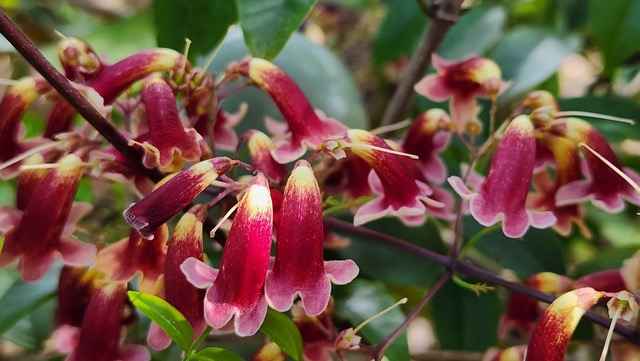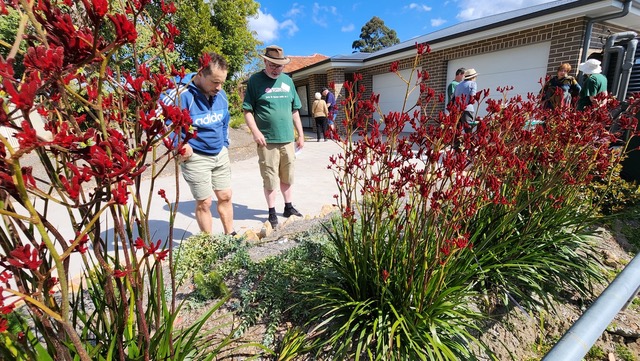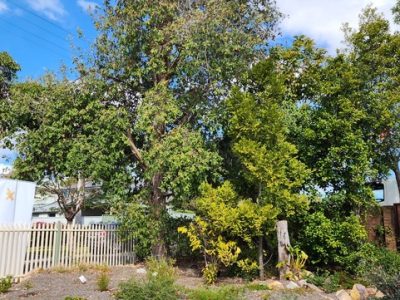
Where it came from
About 40 years ago, in the early 1980s I took the family to stay in some cabins near Racecourse Beach just north of Batemans Bay for the summer holidays, shaded by iconic spotted gums with a burrawang understory. This was long before I got interested in native plants or had joined APS, but I already appreciated the plants that I saw, so I ‘liberated’ a burrawang seedling from just outside the cabin to take home and plant in my garden at Engadine.
About burrawangs – Macrozamia communis
The burrawang is Macrozamia communis, one of 40 species in the Cycad family and all native to Australia. It can be found from the Taree region in the north to near Bega on the far south coast and inland to the ridges of the Great Dividing Range. Macrozamia is from the Greek makros meaning large and Zamia, a genus of cycads, and communis is from the Latin communis meaning common, referring to its abundance in dense stands, sometimes dominating the shrub layer. It is the most commonly occurring and most widespread cycad in NSW and the most southerly occurring cycad species in the world. Its common name, ‘burrawang’, is derived from the Dharuk language spoken by the Aboriginal people of the Sydney and Illawarra regions for whom it provided a food source after thorough treatment. The same common name is frequently misapplied to other Australian cycads.
Burrawangs are cycads
The cycads are an ancient plant, sometimes referred to as dinosaur food. Worldwide there are at least 300 species, with more being discovered all the time, particularly in Central and South America. Some species of cycad found in Mexico can grow to 15 metres tall.
M. communis is a medium to large cycad and has a woody trunk which is 30–80 cm in diameter and 30–200 cm tall. The trunk is typically underground, but may be emergent where growing on shallow soils or on rocky sites. It has 50–100 flat, pinnately compound leaves up to 200 cm long, arranged in a gracefully rounded crown arching out from the central trunk. The literature says that large specimens transplant readily.
All cycads are dioecious, meaning that female and male reproductive organs are situated on separate plants. Female plants typically bear 1–3 cones with hundreds of large seeds turning an orange, bright red, or sometimes yellow when ripe. They can be propagated from seed, but can take 6–24 months to germinate. The cones look a little like a pineapple, although the pineapple plant is actually a bromeliad, not a cycad.
An eruption!
When my house was demolished to be rebuilt, the builders flattened my cycad and planted a portaloo on top! After several months, the new driveway was constructed with the excavated soils being mounded up on top of where the cycad used to be. After some weeks this pile of earth was used to create new garden beds. I used the tree root from my old Syncarpia glomulifera as a feature in the new bed, along with some of the sandstone and the excavated material mounded up against it.
Roughly 12 months after my burrawang plant was ‘destroyed’ by the builders, in about mid January, I noticed what could only be termed an ‘eruption’ of the soil in my new bed. It dawned on me that it was likely to be my cycad and over the next couple of weeks, up she came. For she was a female plant with cones.


Ralph’s new front garden
The cut to create the driveway was around one metre and this material was mounded up and had to be removed. There was a decent amount of quite attractively coloured sandstone removed and I saved as much of this as I could. Some was used to create a retaining wall.
I used some of the smaller lumps of sandstone on the other side of the driveway in a less formal arrangement. The soil on this bed was mounded up to a depth of around 50 cm on top of the original soil level. Everything was then mulched very heavily with a good quality native mix leaf mulch. Other large rocks were used to create a bit of a rockery. Correa ‘Clearview Giant’ and Grevillea ‘New Blood’ were original plants from 2011 and 2014 respectively, and survived the builders.
Another plant that has re-emerged is Alpinia caerulea, native ginger, originally planted in 2010. There were still some large rhizomes underground and several young shoots have now re-appeared. It prefers some shade and was originally in a very shady south facing spot. It is now in full sun, although soon to be shaded by a Grevillea ‘Bronze Rambler’, planted at the top of the bank as a sprawling groundcover.
I’ve planted another grevillea and a banksia at the top of the slope as low growing groundcover forms, to eventually cover and stabilise the bank. G. gaudichaudii is fast growing and reputed to grow only 30 cm tall but spreading to 3 m. It is a naturally occurring hybrid of two grevilleas from the Blue Mountains. One parent, Grevillea acanthifolia grows in swampy areas or on wet rocks and is up to 3 m tall and the other parent is Grevillea laurifolia, a prostrate trailing shrub, spreading to 6 m wide. The banksia is another low-growing and fast spreading form of B. integrifolia ‘Roller Coaster’, a more well-known cultivar. I also have an Eremophila maculata x racemosa purchased from Bilby Blooms, which is very fast growing with pale pink flowers.
On the other side of the driveway is the newly constructed bed, with the sandstone rocks and the freshly laid mulch. The first things that I planted were 3 lilly pillies to form a bit of a hedge and hide the bin area. Eight months later, they have bushed out and the kangaroo paws have taken off. I’ve also started to fill in the rest of the bed with an eclectic assortment of plants.
Part of the front garden was fenced off and protected, so what I call my forest survived. It contains five good sized trees including the turpentine, as well as several shrubs and vines and other shade loving plants. In the corner, this was the deepest of the cuts for the excavation and most of it was rock, with just a thin layer of soil, supporting a surprisingly large NSW Christmas Bush, Ceratopetalum gummiferum, which is so tall the flowers and showy bracts at Christmas are seldom noticed, unless the cockatoos come for a feed and prune it heavily. It is not a particularly bright colour form and it needs a good boy prune with a chainsaw to get it to bush up closer to eye level, at least for a few years.
Hibbertia scandens was planted to scramble over an old dead tree trunk and eventually took over the fence, flowering all year long. The rough treatment by the builders did result in a lot of dieback, so I pruned it heavily and left just a handful of stems. It has now bounced back remarkably well – a tough plant for sure. They seem to seed and germinate quite readily and also appear from underground runners.



The narrow side garden
The house design took up a lot more of the block that we had initially anticipated and down the side, access to our granny flat was close to the boundary, just 1.8m in fact. Having laid the slab, the existing wall between the two properties was deemed not to be strong enough and so we had to construct a new boundary retaining wall, before the builder would continue. We found plenty of rock too. Steel reinforcing went in for the foundation and the wall went up, with help from an excellent labourer and we ended up with a good solid structure. Then the hole was back-filled and compacted so the builders could continue. Six months later, the path was laid and I asked for a small bed to be left, just 30 cm wide next to the wall. The larger rocks were then removed, some of the stockpiled soil added and finally a layer of mulch. So what to plant that will grow in such a tough location with pretty ordinary soil, south facing next to a 1.8 m high fence and it couldn’t be something that would get too big and impede access? It is still a work-in-progress as of January 2023, 6 months after we moved in.
First up I sourced some Cordyline rubra pups from Joan Deegan’s garden and they seem to be doing OK so far. Next up were a couple of Davidson Plums, which had come up as seedlings in a friend’s garden. They typically grow up rather than outwards and have such pretty leaves. Peter Shelton donated a couple of prostrate Zieria, so trying one here as a ground cover and my latest addition is Grevillea candelabra, from Phil Keane, which also typically grows straight up. [Joan Zande also had a Grevillea candelabra in full flower at her front door at her Open Garden]. Donations and ideas for other plants gratefully accepted.

The rear garden at the back of the house
Making a bit of a yard for the dwelling alongside and then a deck area from my side takes up most of the remaining room at the back of the property. The existing vegetation along the back fence, mainly fruit trees, was retained, so I have a lemon, a lime, an orange and a native finger lime. There is also a mango grown from a seed, but recently ring-barked by the dreaded possum, so it is looking pretty sick and may have to go. Perhaps the most vigorous plant I have at the back is Tetragonia tetragonioides or Warrigal Greens, which needs constant attention or will just take over the garden, but it does suppress the weeds pretty well and is host to a lot of insects. Although I don’t eat a lot of it, it stays for now. It also self seeds prolifically, so also needs weeding out of other areas, despite the mulch.
I also have the very attractive Syzygium luehmannii, or Riberry, which has continual flushes of brilliant new growth and brightly coloured edible berries in late spring. On the deck and under the pergola, I have several plants in pots as well as other smaller shrubs vying for room and light amongst the larger trees. Jan Taylor donated several orchids, which have found a home here too.

